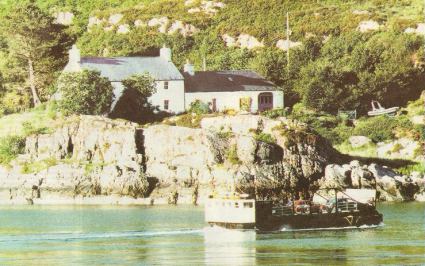

Skye Ferry

Glenelg-Kylerhea Ferry
The last hand operated turntable ferry in the world?
The answer is probably, according to The Isle of Skye Ferry Community Interest Company who are the new owners of this traditional route to the Isle of Skye. The present ferry "Glenachullish" takes, depending on tidal conditions, approximately five minutes to complete the five hundred and fifty metre crossing and can accommodate up to six vehicles.
The ferry operates seasonally between Easter and October.
This, the shortest point between Skye and the mainland has been a crossing point for centuries. Johnson and Boswell stayed at the nearby (original) Glenelg Inn in 1773. You can still see it If you look to the right when turning onto the ferry slipway on the Glenelg side (it's now a private house) as is the original Kylerhea Inn, which you’ll pass when you leave the ferry on the Kylerhea side. The two identical inns were built to accommodate cattle drovers, who would take cattle from all over Skye and the Uists to this crossing point and then onwards to the cattle markets of Crieff or Falkirk in the south. Up to 8,000 cattle a year would be swum across the Kyle at slack water, usually, in groups of five, tied together, nose to tail using heather or straw rope. This way, one hundred could be transferred to the mainland in a single day.
A Kylerhea man, Lachie MacInnes, started the first vehicular ferry in 1935. He had a ferry built, which was capable of taking two cars. The service was discontinued with the outbreak of war in 1939. Murdo Mackenzie and his father restarted the vehicular ferry service in the late 1950's. Their main problem was finding a suitable boat to use as a ferry. Murdo knew that Lachie MacInnes's boat had been sunk in Loch Nevis, so he went over and managed to get her afloat - he even managed to get the original paraffin engine running, though this was eventually superseded by a diesel one. At that time, there were only three cars in Glenelg (and the MacKenzie family owned one of them!) and with hardly any good tarred roads business was slow. Gradually it built up and after thirty-three years running the ferry and ending up with the last of the Ballachullish ferries (Now a bridge south of Fort William) the service was sold to Roddy Mcleod who operated it until its purchase by The Isle of Skye Ferry Community Interest Company.
The Kylerhea Straits are named after the Fingalian hero Reatha, who according to legend drowned while trying to vault the Kyle using his spear and thereafter gave the crossing its name.
When you disembark on the Kylerhea side take time to visit the Broadford and beyond.
Additional Information:
Link to YouTube video of Glenelg Skye Ferry crossing
Link to YouTube video of Kyle of Lochalsh to Kyleakin Skye Ferry crossing
Link to YouTube video of Ballachulish Ferry crossing
Location:
Glenelg Slip: 57.2291; -5.6557
Kylerhea Slip: 57.2277; -5.6644












